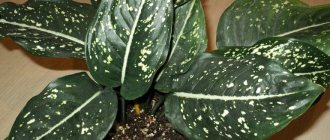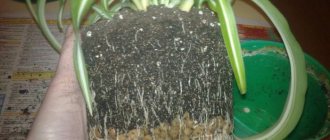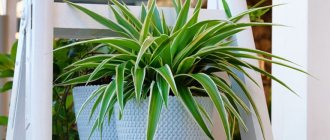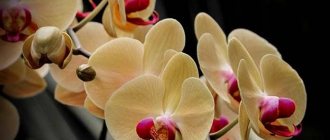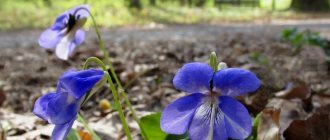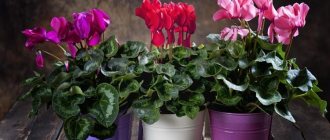Author: Elena N. https://floristics.info/ru/index.php?option=com_contact&view=contact&id=19 Category: Houseplants Published: September 18, 2012Republished: February 17, 2019Last edits: April 8, 2021
For as long as I can remember, this green shaggy bush has been growing in our house. True, in my childhood my mother called it “spider,” but now I already know its botanical name - Chlorophytum comosum. This lush bush feels great in almost any conditions. I appreciate it for its unpretentiousness and resistance to disease. Mom loves how elegant and decorative chlorophytum looks in hanging flowerpots. And all my friends are surprised by the exquisite beauty of the flowers of this plant. They look like tiny lilies - simple and aristocratic at the same time. And this is not surprising, because chlorophytum belongs to the Liliaceae family. It is even sometimes called the “lily of St. Bernard”.
Features of the plant
Although Chlorophytum crested is considered an unpretentious plant, it still requires some care. If I were asked to formulate these rules in one sentence, I would say: “The main thing is not to overdo it.” Why?
In short, because Chlorophytum DOES NOT NEED:
- big pot,
- a lot of fertilizers
- saturated earth,
- a lot of light.
All these features are due to the fact that Chlorophytum is an epiphytic plant. That is, in nature it grows - like all epiphytes - on the bark of trees, in trunk cracks and crevices. This plant is native to the humid tropics and subtropics of South Asia, South Africa and Australia. The climate in these regions is humid and warm most of the year. Chlorophytum under natural conditions manages to grow and produce several “babies” - new daughter shoots. But these places also often experience periods of drought. Then the chlorophytum survives due to the moisture accumulated in the succulent roots. Now, taking into account everything that has been written, we can come to the conclusion that caring for chlorophytum at home should be moderately reasonable.
Thanks to its unpretentiousness, Chlorophytum crested has been successfully cultivated in greenhouses for more than 200 years. True, this plant became an indoor plant only at the end of the 19th – beginning of the 20th centuries. The name of this flower is deeply symbolic. Chlorophytum comes from two words: “chloros” - “green” and “phyton” - “plant”. Now there are more than 215 species of Chlorophytum.
- Ficus benjamina sheds leaves - why (part 1)
Popular varieties
The genus Chlorophytum contains 100-150 species (the differences are due to different systematic approaches to the species included here or to the genera Anteriaum and Dasystachys). All representatives are perennial plants growing in tropical regions of Asia, Africa, Australia, America, most species are found in Africa. A popular cultivated species, Chlorophytum comosum, is grown as a potted plant in temperate climates. Its leaf blades are long and narrow. It is also called Chlorophytum Sternberg in honor of the Czech botanist Caspar Sternberg.
The most common varieties of chlorophytum found in garden stores are:
- Chlorophytum comosum bonnie - has yellow inflorescences, the leaves bend into decorative arches, are quite wide, light green, decorated with a whitish stripe in the center. Lush, disheveled bushes form.
- “Ocean” Ocean is a variety with wide light green leaves with cream edges. The variety is especially sensitive to excess water and too shady position. Its shape is more compact, dense, stocky.
- “Milky Way” Milky Way is a unique variety that is less commonly found on sale. The leaves are somewhat reminiscent of the leaves of miniature bamboo trees - they sit on long green petioles, are arranged horizontally, slightly curving downwards. The center of the leaf blade has a dark green stripe.
- “Lemon” Lemon - shiny, long, freely hanging leaves of the variety look great at home. The young foliage of the variety is lighter, which contrasts beautifully with the old dark green.
- "Variegatum" Variegatum is the most common variety, the leaves are cream with green edges. Reaches a height of 20 cm.
- "Vittatum" Vittatum - leaf blades are gray-green with a wide white stripe in the center. Reaches 30 cm.
- "Zebra" Zebra - leaves of the variety are dark green, decorated with yellow stripes along the edges.
- “Green Orange” Green Orange – also called chlorophytum orange – is a variety with an unusual color. Wide lanceolate leaves on orange petioles have orange veins. The combination of these colors looks incredibly impressive!
- "Hawaiian Spider" Hawaiian Spider - this variety is distinguished by an elegant dark green border of leaves and a warmer color of a creamy center. The leaves are saber-shaped, long, with sharp tips, wider and stiffer than those of other varieties. Yellow stripes run through the middle of the plate.
- "Atlantic" - grows up to 30 centimeters in height. In this variety, the edges of the leaf blade are decorated with dark green stripes; a strip of light green or pale yellow runs through the center. In spring, small flowers grow on long leafless stems.
Soil and flowerpots
This is a flower that does not require any special soil. A floral, neutral soil (pH about 6-7) is suitable. It should be loose and light. If you make up an earthen substrate yourself, for chlorophytum take the following components: turf, leaf soil, humus soil and sand (2: 2: 2: 1, respectively). If there is no humus component, you can add more turf soil.
Chlorophytum crested is a tropical plant, so its roots grow a lot, so I choose wide flowerpots. You need to have good drainage at the bottom.
Caring for chlorophytum at home
Chlorophytum is considered one of the most unpretentious houseplants, so even a beginner can care for it. Timely watering and replanting, sufficient light and a warm room - these are the basic principles of caring for the Spartan from Africa. But, if you want to create optimal conditions for your green pet, it is worth studying the rules for keeping chlorophytum in more detail.
Temperature and lighting
The range of temperatures suitable for chlorophytum is quite wide - from 17°C in winter to 27°C in the summer months, and in winter even a short-term drop in temperature to 10°C is possible.
The plant is not demanding on lighting and cannot tolerate, perhaps, only a complete lack of natural light or, conversely, an excess of bright sunlight. The best lighting conditions are diffused light or partial shade on western and eastern windows. In the hot season, it will be useful to take the plant out into the fresh air: loggia, balcony, garden plot.
[!] Curly and variegated varieties are more demanding on lighting conditions: with a lack of light, decorative qualities are lost.
Watering and air humidity
For all its unpretentiousness, chlorophytum is quite picky about watering. The plant needs a fairly large amount of moisture, because under natural conditions the perennial prefers to settle in floodplains. However, excessive watering, like drought, will also damage the plant and can lead to the formation of root rot.
The optimal watering regime for chlorophytum in the hot summer months is 2 times a week. In winter, watering can be more moderate: once every seven days. For irrigation, it is better to use soft, settled or filtered water.
[!] Chlorophytum can withstand quite long (1-1.5 weeks) drought: the roots of the perennial have special thickenings in which moisture accumulates, which the plant uses when there is a lack of water. [!] When watering chlorophytum, try not to pour water into the middle of the bush, where the growing point is, but water the substrate at the edge of the pot.
Air humidity is not a very important parameter for growing chlorophytum: the normal climate of an apartment is quite suitable. But, if you want the plant to be healthier and grow faster, spray it once a week in the summer. In winter, spraying can be eliminated completely.
Trimming
In order for the chlorophytum to remain lush, the plant must be pinched or trimmed periodically. The following are subject to removal:
- dried leaves;
- yellowed leaves;
- leaves that are spotted or blackened;
- extra mustache with leaf rosettes
[!] A large number of leaf rosettes harm the mother plant, intensively consuming its vitality. For the best condition of chlorophytum, it is necessary to cut off excess, overgrown layers closer to the base.
Soil and fertilizing
Chlorophytum does not require special soil; it can be planted in almost any nutrient substrate. It is necessary to pay attention only to the acidity of the soil and exclude too acidic or, conversely, alkaline mixtures. The best option is neutral soils (pH from 6.6 to 7.2).
From ready-made store-bought soils, you can choose a nutritious universal soil or soil mixtures for roses, begonias or palm trees. To independently prepare the substrate, you need to mix turf, leaf, humus soil with sand in a ratio of 2:2:1:1. It would be a good idea to add some coal to the soil. You will also need a drainage layer (expanded clay, vermiculite, clay shards) at least two centimeters high.
It is not at all necessary to feed chlorophytum intensively: an adult perennial gets everything it needs without fertilizers. But, for the best condition of the plant, in the spring-summer period it is possible to use mineral or organic fertilizer (Bona Forte, Planta Miracle and others). Fertilizers will also be useful during the period of growth and development of young chlorophytum.
Transplantation and propagation
Whether there is a need to replant chlorophytum can be determined by several signs:
- the roots do not fit in the bowl and begin to appear on the surface of the soil;
- the plant has stopped growing, there are no new shoots, flowering does not occur
Transplantation is best done in early spring, in February or March, before the period of rapid growth begins, into a container approximately one-quarter larger than the previous one.
Chlorophytum is propagated in several ways:
- Leaf rosettes;
- Dividing the bush;
- Seeds
Which one to choose depends on the type of perennial. Let's look at each method in more detail.
Propagation by leaf rosettes is the easiest option that even a novice gardener can handle. From the adult mother plant, it is necessary to separate and root the formed leaf rosette located on the creeping shoot (whisker) of chlorophytum. Rooting occurs in water or in a peat-sand mixture. After a sufficient number of roots about 3 cm long appear, the young chlorophytum can be transplanted to a permanent place of residence. Due to the high survival rate of chlorophytum, the rosette can be planted directly into the ground.
[!] The method is not suitable for propagating Chlorophytum cape and Chlorophytum winged, since these species do not have leaf rosettes.
It is also easy to propagate chlorophytum by dividing the bush. The procedure is carried out during transplantation of an adult perennial specimen. The plant is removed from the pot and, using a sharp knife, divided into the required number of parts, after first freeing the roots from the ground. Each part should have one or more healthy shoots and root shoots. After separation, the resulting plants are planted in new containers and watered abundantly.
Propagation of chlorophytum by seeds is a rather exotic technique, more appropriate for breeders developing new varieties. In order to germinate seeds, you need to place them in a damp cloth or simply in water for several days. Then the prepared seeds are sown in a container with a mixture of sand and peat, practically without deepening them. For better germination of chlorophytum seeds, the container can be covered with film or a piece of glass and placed in a warm place, thus creating a greenhouse effect. In this case, the soil with seeds must be periodically watered, and the film must be removed and the container ventilated. After the seeds germinate and the first few leaves appear, the plants can be transplanted into a regular substrate.
[!] When planting young chlorophytums, place them in a pot several at a time - an adult bush will look more magnificent and decorative.
Diseases, pests and growing problems
Pests rarely appear on chlorophytum, but sometimes the plant is attacked by mealybugs, aphids, nematodes or thrips. All these insects are destroyed by folk remedies if their numbers are small or by insecticides when the colony has spread. Read more about pests here.
As for diseases, chlorophytum is quite resistant to them. The main threat to perennials is root rot, which occurs due to excessive watering. All other diseases also appear due to improper care:
- Brown, drying tips of leaves - excessive watering or stagnation of water in the pan. What to do - remove water from the pan, limit watering;
- Brown spots on the leaf plate - too bright lighting, sunburn, mechanical damage. What to do - shade the chlorophytum;
- The leaves have lightened, the decorative stripes have disappeared - soil depletion, the pot is too small, lack of light. What to do - move the plant to a more illuminated place, feed it, transplant it into a larger container;
- Lethargic, drooping leaves - overwatering, the formation of root rot, poor lighting. What to do - check the roots (cut off rotten areas, sprinkle the cut areas with coal), replant, reduce watering, change the location of the plant;
- Brown stripes along the central leaf vein - the container is too large, overflow, root rotting. What to do - transplant into a smaller pot, review the watering regime, check the roots;
- Chlorophytum does not bloom and does not produce shoots - the pot is too large. What to do - plant it in a small, cramped container;
- Leaves break in half – mechanical damage. What to do - do not injure the chlorophytum, if necessary, place several supports for the leaves;
- Black tips of leaves mean very dry air. What to do - periodically spray, place a container of water next to the plant
As you can see, chlorophytum is a very beautiful and unpretentious houseplant that can bring a lot of joy to its owner. And if you are still wondering whether you need this flower, then here is:
And sun, and partial shade, and even shadow
Chlorophytum is very adapted to survive in various conditions, so it tolerates any lighting. This flower can grow in the sun, in the shade, and in partial shade. But... The bright sun can dry out the soil in the pot, and the leaves turn somewhat pale, as if they are fading. In strong shade, the leaves also do not have enough ultraviolet radiation to produce pigment, and they lose their brightness. Therefore, it is best to position Chlorophytum so that it is in partial shade for most of the day, and direct sunlight hits the plant only a few hours a day.
For example, I grow Chlorophytum in a hanging pot on the wall, opposite the southwest window. Diffused sunlight falls on the flower from 14 to 18 hours. This is enough for the plant to feel great.
This flower is also quite tolerant of temperature changes. Temperatures from 12 to 25°C are suitable for it. In hot weather, frequent spraying is necessary to maintain the required humidity. And in winter it grows even at a temperature of 12-14°C (but not lower than 10-12°C). But still, chlorophytum is a lover of heat.
Useful properties of chlorophytum
Chlorophytum is an ideal air purifier, the “green lungs” of the home. By drawing in harmful carbon compounds (formaldehyde, chlorethylene, benzene), it generously shares oxygen. The plant releases phytoncides that disinfect indoor air. Reduces the concentration of heavy metals and their compounds; neutralizes nicotine.
Therefore, the chlorophytum flower is indispensable in apartments where smokers, allergy sufferers and people with pulmonary pathologies live. By purifying the air, chlorophytum also moisturizes it and helps absorb extraneous noise. Over the course of a day, 5 average plants neutralize dangerous compounds over an area of 10 m2. In African countries, chlorophytum is used as a laxative for children.
Reproduction by children and more
Many gardeners leave “babies” so that the flower looks three-dimensional and lives up to its name Chlorophytum crested. But this weakens the mother plant. How to be? It is best to cut off the overgrown tufts from time to time and use them as planting material. And Chlorophytum will raise you new children in return.
Most often, this “flying” flower is propagated by children - shoots from the main plant. As a rule, a lot of them appear already in the first year of Chlorophytum’s life. Thin stems extend from the flower, on which white small flowers first appear, and then in their place bunches of leaves grow. These hanging spiders already have their own tiny aerial roots.
You can dig a rosette of leaves into a nearby pot of soil without cutting off the stem. When the plant is well rooted, the shoot will need to be separated. You can simply tear off the “baby” and put it in water so that roots 2-2.5 cm long grow. Afterwards, the sprout is planted in a separate pot.
Chlorophytum crested is also propagated by seeds or by dividing the bush during transplantation. The first method is quite labor-intensive. But by dividing a plant during replanting, you can not only propagate it, but also improve its health - especially if the roots have grown very large and they lack nutrition. Dividing the plant will then give the root system more room to grow.
By the way, replanting Chlorophytum crested is most successful in the spring - before the period of stormy growing season.
- Anthurium at home
Reproduction of chlorophytum
Depending on the type of plant, propagation of chlorophytum is possible in different ways.
Growing chlorophytum from seeds
Acceptable for species that do not form “children,” for example, for Chlorophytum orange.
- Fresh seeds are wrapped in a moistened napkin and placed in a plastic container.
- Cover with a lid and germinate at + 25 - 28°C, periodically wetting the napkin.
- After 2 weeks, when the seeds “hatch”, they are planted in moist soil to a depth of 5 mm, trying not to damage the long white sprout.
- Cover with film and leave in a warm place.
- The film is removed to water and ventilate the plant.
- When true leaves (2–3) form, the seedlings dive.
Reproduction of chlorophytum by rosettes
A simple method in which rosettes that have grown to 5–8 cm are separated from the peduncles. By this time, many rosettes already have roots, but if they are not there, the bush is rooted in loose soil or in water (the water must be changed more often). When rooting in water, wait for roots to appear. Then they are planted in the soil. Young “babies” take root quickly. Crested and curly species are easily propagated by this method. But the method is not suitable for winged and cape chlorophytum: they do not have “whiskers”.
Reproduction of chlorophytum by dividing the bush
Such propagation is timed to coincide with plant transplantation.
- When a plant is removed from a pot, the rhizome is washed.
- Using a sharp knife, divide it into fragments and sprinkle the cut areas with charcoal powder.
- Damaged roots are removed, elongated roots are shortened by half.
- The prepared parts are planted in the ground. A quick option for getting a powerful bush.
In this way, it is recommended to rejuvenate the bush once every 5 years. This method is suitable for propagation of all species.
The most favorable time for the propagation of chlorophytum is spring, when chlorophytum, which has rested over the winter, is ready to give birth to a new plant.
Not painful, but needs attention
Chlorophytum crested is little susceptible to various diseases. But if not cared for properly, even he can get sick. This is how aphids sometimes appear on a plant, especially if it is located next to flowers that are highly susceptible to this scourge. A mealybug may also appear, especially if you overdo it with watering.
The leaves take on a brown tint along the edges both when over-watered and when there is a lack of water. Flooding can also cause the roots to rot.
Spider mites or scale insects can also settle on a weakened plant. I treat Chlorophytum with a soap solution. If the plant is very sick, you need to use Actellik (1 ml/l of water).
Diseases and pests
Usually, with proper care, chlorophytum grows healthy and beautiful - a real “green plant”, but sometimes it is attacked by diseases and pests. The flower will announce the problem by changing its appearance:
- the leaves of chlorophytum turn yellow - rot of the roots from the fungus (if the root is completely blackened, the plant cannot be saved; if minor areas are affected, they are removed, the cut areas are sprinkled with coal powder, transplanted into new soil and not watered for several days, kept in the shade);
- brown tips of chlorophytum leaves - lack of nutrients or high temperature in the room (feed, move to a cool place, ventilate);
- brown stripes on the leaves of chlorophytum in winter - excess moisture (you can dry the roots, replant the flower in new soil, do not water for several days; adjust watering);
- curled leaves with yellow-brown spots, brown edges of chlorophytum leaves - severe moisture deficiency (water abundantly, adjust watering);
- chlorophytum grows slowly - lack of nutrients, little light (feed, move to a brighter place, turn on the phytolamp);
- Chlorophytum does not produce babies - the pot is cramped or the flower is immature (transplant into a more spacious pot);
- Chlorophytum leaves turn pale - little light or lack of nitrogen (move to a brighter place, feed);
- rots in the center - excess moisture (dry the roots of the flower, replant in new soil, do not water for several days, then adjust the watering);
- the leaves have become soft - the plant is cold (move to a warm place);
- light brown dry spots on the leaves – sunburn (shade);
- dry tips of leaves - dry air in the room (spray, place on a tray with moistened expanded clay);
- chlorophytum begins to fall on its side - the bush has grown too large (divide into fragments and replant);
- leaves turn black in summer - little moisture, dry air (water generously, spray, place on a tray with wet expanded clay).
Sometimes chlorophytum is affected by insects: thrips, aphids, mealybugs, nematodes. Insecticides are used against them. If there are few pests, you should first try traditional methods.
Characteristics of the flower Crested chlorophytum
The plant's homeland is sultry Africa, but today it can be found on almost all continents. Chlorophytum is a perennial herb that came to Europe only at the end of the 19th century and immediately gained popularity due to its rich green color. And the Latin name of this culture, Chlorophytum, translates as “green plant.” This climbing flower has the following characteristic features:
- narrow and long leaves, reaching 50 cm in length and no more than 3 cm in width, which grow in bunches and create a shaggy crown;
- fleshy roots that go 10 cm deep into a container with soil;
- the presence of small flowers on a branched inflorescence;
- flowers come in green and white shades;
- the seeds are in capsules;
- inflorescences contain hanging shoots with babies;
- leaves can be either single-colored or with white stripes.
Because of the long shoots, chlorophytum is popularly called “spider”, and botanists prefer the name “tufted”, indicating the specific growth of the leaves of this representative of the Liana family.
Signs and superstitions
The widespread cultivation of chlorophytum is due not only to its unpretentiousness to care and soil quality, but also to its beneficial qualities. Leaves are able to synthesize oxygen in their cells, purify the indoor air from harmful impurities, and fill the house with positive energy.
According to popular beliefs and traditional superstitions, home flowers are usually endowed with various positive or negative qualities. It is believed that the presence of some plants in an apartment scares away men, others attract financial wealth, others are capable of healing, etc.
Can decorate both the house and the yard
One of the important advantages of chlorophytum is its versatility in interior design. Chlorophytum can be hung on the wall in a flowerpot or placed on a high stand; species growing in a cascade will look especially impressive.
Chlorophytum transformed an ordinary flower stand into a real pedestal
Chlorophytum loves diffused light, which means it will feel great on a flower stand or shelf, which is located in the back of the room with a large and wide window.
In a laconic white interior, chlorophytum is a spectacular color accent
In a kitchen of any size and design, chlorophytum is not just a great decoration, but also an excellent air purifier.
Chlorophytum will never be superfluous in the kitchen
And if the size of your kitchen allows it, place the plant directly on the counter; a work area decorated in this way will lift your spirits and distract you from the monotony of cooking.
Such a companion will help brighten up the routine of kitchen work.
The ability of chlorophytum to normally tolerate light shade allows you to decorate a window by hanging hanging flowerpots directly on a curtained window, enlivening a usually boring window square.
Chlorophytum can decorate even a shaded window
Placed between other indoor plants, chlorophytum always fits harmoniously into a green composition.
Chlorophytum in ensemble with other plants makes the flower arrangement complete and original
Even in the bathroom, where there is natural light, chlorophytum is easy to use and pleases the eye with fresh greenery.
Even in the bathroom, chlorophytum has found its place
Chlorophytum taken out into the fresh air in the warm season allows you to enliven a balcony, courtyard or terrace.
Spectacular chlorophytum distracts attention from an unpresentable fence
Florists who are keen on landscape design will be very pleased with the fact that here, too, chlorophytum, thanks to its lily-like appearance, is in great demand and successfully forms plant compositions near ponds.
And near water, chlorophytum is not at all superfluous
This is how, without great expense, but with great imagination, you can decorate any interior with the help of a simple, no-frills, but beautiful chlorophytum plant.
Types of chlorophytums with name and photo
Chlorophytum crested
The most common species in indoor floriculture is distinguished by narrow, long green leaves, along the edges of which there are longitudinal light stripes. The foliage forms a leaf rosette, the diameter of which reaches about 50 cm. Crested chlorophytum blooms with small white flowers, instead of which, after flowering, children are formed in the form of small rosettes. They are located around a leaf rosette on long arrows, which is why the bush looks like a fountain.
Popular varieties of Chlorophytum crested:
- Ocean is a plant with variegated leaves that are arranged in a spiral;
- Laxum - the variety is distinguished by variegated leaves arranged in a fan shape, along the edge of which there is a white stripe;
- Variegata - the light leaves of the plant are distinguished by a silvery edging;
- Vittatum is a variety with dark green leaves with a white stripe running down the center.
You will be interested to know: How to grow a palm tree from seeds, palm tree propagation by dividing the bush
Chlorophytum winged or orange
The perennial with oval wide leaves located on fleshy small petioles has a height of 30 to 40 cm. The whole beauty of the plant lies in the fact that the orange petioles and central vein contrast beautifully with the dark green leaves. During flowering, a short peduncle with a spadix-like inflorescence is formed.
Chlorophytum cape
The plant with leaves up to 60 cm long is distinguished by monochromatic light green foliage, unattractive flowers and short peduncles. The Cape species reproduces by dividing the bush, since it does not form daughter rosettes.
Chlorophytum curly or Bonnie
A beautiful compact plant with leaves twisted into a spiral. The bush also looks beautiful because there is a contrasting white stripe along the central vein of each leaf.
The described species and varieties of chlorophytum are the most popular among gardeners. In total, about 200 species of this beautiful plant are known.
Watering
Abundant, but in moderation. Do not overdry or over-moisten the soil.
In summer, the flower is watered often - every 2-3 days, on hot days - more often. In winter, once a week is enough, when the soil is partially dry, but make sure that the soil does not dry out completely.
It tolerates infrequent watering due to the peculiarities of the root system, but with constant overdrying it loses its decorative qualities.
In summer it is useful to have a warm shower.
If water gets into the center of the socket, carefully remove the moisture.
It does not require high humidity, but if there is a lack of it, the tips of the leaves may dry out. In this case, additional air humidification is required.
Interesting Facts
Chlorophytum crested is not just a decorative air freshener. Here is some more interesting information about the flower:
- It has been used for indoor landscaping for 200 years.
- Due to the shape of the flowers, the plant has another name - St. Bernard lily.
- The plant not only absorbs carbon dioxide, but also destroys pathogenic microorganisms.
- Growing Chlorophytum crested is an excellent solution for those who are subject to great mental stress. In rooms with this plant there is always healthy air, rich in oxygen.
Important Chlorophytum is dangerous for cats. Its leaves contain hallucinogenic substances that attract pets, as well as chemical compounds that cause vomiting and diarrhea. Restrict cats' access to the planter by hanging it or placing it on a stand.
Its love of life and ease of care make chlorophytum one of the most popular indoor plants among novice gardeners. But professionals are also attracted to the decorative bush with striped leaves.
